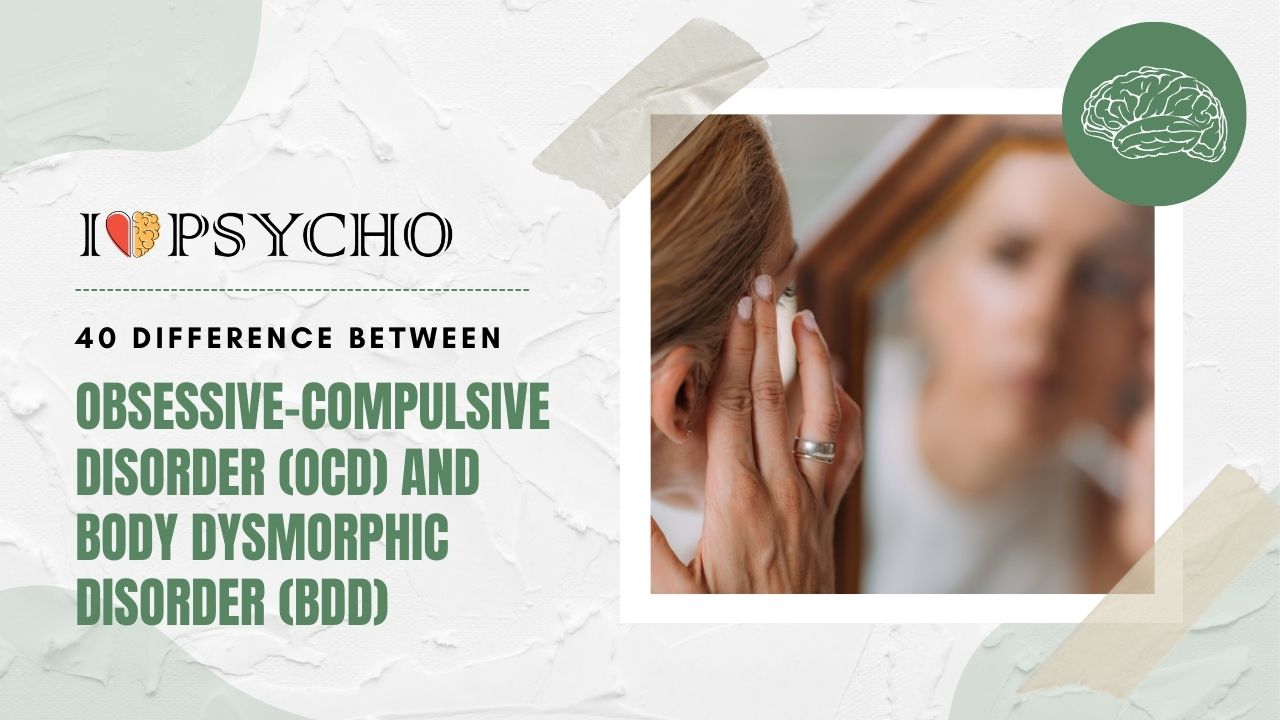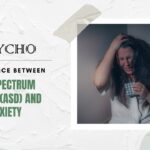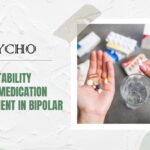Both OCD and BDD are mental health diseases with distinct symptoms and processes. Although both include repeated behaviors and upsetting thoughts, they differ significantly. Intruding thoughts, images, and cravings constitute the foundation of OCD. OCD sufferers utilize compulsions to reduce anxiety. Rituals may involve handwashing, checking, or counting. BDD, on the other side, is characterized by obsessive preoccupation with physical imperfections. This can cause obsessive grooming, mirror checking, and appearance reassurance.
Their emphasis distinguishes these illnesses. OCD fears many things, but BDD fears the body. The cognitive processes behind them differ too. The person with OCD knows their obsessions and compulsions are unreasonable yet nonetheless performs them. In BDD, the apparent problems are truly thought to exist, and efforts to fix them are driven by this belief.
Also, treatment methods differ. Overcoming obsessions and learning to handle anxiety through exposure and response prevention treatment usually helps OCD. However, cognitive-behavioral treatment for body image difficulties can help BDD sufferers overcome negative self-image thoughts.
The two illnesses differ in social interaction. owing to excessive self-consciousness about their looks, BDD sufferers may isolate themselves, whereas OCD sufferers may hide their symptoms owing to stigma. OCD usually starts in childhood or early adulthood, while BDD usually starts in adolescence.
OCD and BDD have different foci, cognitive processes, treatment techniques, and societal repercussions. BDD entails obsessing about physical imperfections, whereas OCD involves painful obsessions and compulsions. Recognition of these variances is essential for proper diagnosis and successful treatment strategies customized to each disorder’s particular problems.
Here are 40 differences between Obsessive-Compulsive Disorder (OCD) and Body Dysmorphic Disorder (BDD):
|
S.No. |
Aspects |
OCD |
BDD |
|
1 |
Definition |
OCD is an anxiety disorder characterized by persistent, unwanted thoughts (obsessions) and repetitive behaviors (compulsions). |
BDD is a mental health disorder where individuals are excessively preoccupied with perceived flaws in their physical appearance. |
|
2 |
Focus of Concern |
OCD primarily involves obsessions and compulsions related to various themes, not limited to appearance. |
BDD focuses specifically on appearance-related concerns, such as perceived flaws or defects. |
|
3 |
Repetitive Behaviors |
In OCD, compulsions are repetitive actions performed to alleviate anxiety related to obsessions. |
In BDD, compulsions are less common, and individuals often engage in checking, grooming, or seeking reassurance regarding their appearance. |
|
4 |
Core Symptoms |
OCD’s core symptoms are obsessions (intrusive, distressing thoughts) and compulsions (ritualistic behaviors). |
BDD’s core symptoms are preoccupation with appearance and extreme distress over perceived flaws. |
|
5 |
Insight into Disorder |
In OCD, most individuals have insight into the irrationality of their obsessions and compulsions. |
In BDD, individuals often have poor insight and believe their perceived flaws are real and significant. |
|
6 |
Comorbidity |
OCD is commonly comorbid with other anxiety disorders, depression, and eating disorders. |
BDD often co-occurs with depression, social anxiety, and other body-focused disorders. |
|
7 |
Age of Onset |
OCD typically has an earlier onset, often in childhood or adolescence. |
BDD commonly begins in late adolescence or early adulthood. |
|
8 |
Gender Differences |
OCD has a relatively equal gender distribution. |
BDD is more prevalent in females. |
|
9 |
Triggers |
OCD can be triggered by various obsessional themes, including contamination, harm, or religion. |
BDD is typically triggered by perceived defects in appearance. |
|
10 |
Fear vs. Dissatisfaction |
OCD is driven by fear and anxiety, related to the consequences of not performing compulsions. |
BDD is driven by dissatisfaction with one’s appearance. |
|
11 |
Diagnostic Criteria |
OCD is diagnosed using specific criteria outlined in the DSM-5 (Diagnostic and Statistical Manual of Mental Disorders). |
BDD has its diagnostic criteria in the DSM-5 but is categorized under the obsessive-compulsive and related disorders section. |
|
12 |
Treatment Approaches |
OCD is often treated with exposure and response prevention (ERP) therapy and medication (e.g., SSRIs). |
BDD is commonly treated with cognitive-behavioral therapy (CBT) and may involve medication (e.g., SSRIs) as well. |
|
13 |
Social Avoidance |
People with OCD may avoid certain situations due to their obsessions and compulsions. |
People with BDD may avoid social situations due to appearance-related distress. |
|
14 |
Impact on Daily Life |
OCD can interfere with various aspects of daily functioning due to time-consuming rituals. |
BDD can also significantly disrupt daily life, primarily due to excessive grooming and appearance-checking behaviors. |
|
15 |
Insight Spectrum |
OCD falls on a spectrum from good to poor insight, with some individuals recognizing their obsessions as irrational. |
BDD often features poor insight, with individuals unable to see their perceived flaws realistically. |
|
16 |
Self-Harm Behaviors |
In some cases, individuals with OCD may engage in self-harm as a compulsion, but it’s not a defining feature. |
Self-harm is less common in BDD but may occur as individuals attempt to alter their appearance. |
|
17 |
Cognitive Distortions |
OCD involves cognitive distortions related to perceived threats or dangers. |
BDD involves cognitive distortions regarding one’s physical appearance. |
|
18 |
Hoarding |
Hoarding is a subtype of OCD where individuals compulsively collect and cannot discard items. |
Hoarding is not a defining feature of BDD. |
|
19 |
Relationship with Others |
People with OCD may have relationship issues due to the time and energy devoted to rituals. |
BDD can strain relationships as individuals become preoccupied with their appearance and may seek excessive reassurance. |
|
20 |
Treatment Response |
OCD often responds well to evidence-based treatments, with a reasonable chance of symptom reduction. |
BDD can be more challenging to treat, and individuals may have a lower rate of symptom improvement. |
|
21 |
Genetic Factors |
Genetic factors play a role in the development of OCD. |
Genetic factors are also implicated in the development of BDD. |
|
22 |
Sensory Disturbances |
Some individuals with OCD may experience sensory issues, such as feeling contaminated. |
BDD does not typically involve sensory disturbances. |
|
23 |
Perfectionism |
Perfectionism is a common trait in OCD, leading to compulsions aimed at achieving perfection. |
Perfectionism may be associated with BDD, but it is not a defining feature. |
|
24 |
Cognitive Rigidity |
Individuals with OCD may exhibit cognitive rigidity and difficulty adapting to changes. |
Cognitive rigidity is less pronounced in BDD. |
|
25 |
Avoidance of Triggers |
People with OCD may avoid situations that trigger their obsessions. |
Individuals with BDD often avoid mirrors or other reflective surfaces. |
|
26 |
Fear of Harm |
OCD may involve fears of harm or danger to oneself or others. |
BDD is primarily concerned with perceived flaws and not harm-related obsessions. |
|
27 |
Cultural Influences |
Cultural influences can affect the content of OCD obsessions, but the core features remain similar. |
Cultural factors may shape the specific appearance concerns in BDD. |
|
28 |
Personal Significance |
OCD obsessions may have no personal significance but still cause distress. |
BDD symptoms are centered around the individual’s appearance and perceived significance. |
|
29 |
Treatment Duration |
OCD treatment can vary in duration but often involves more extended therapy sessions. |
BDD treatment duration may be shorter for some individuals. |
|
30 |
Preoccupation Duration |
OCD obsessions can vary in duration but tend to be shorter-lived than BDD preoccupations. |
BDD preoccupations are typically more chronic. |
|
31 |
Physical Symptoms |
OCD primarily involves psychological symptoms (obsessions and compulsions). |
BDD may lead to physical symptoms related to excessive grooming or cosmetic procedures. |
|
32 |
Fear of Contamination |
Contamination obsessions are a common subtype of OCD. |
Contamination concerns are not a primary focus in BDD. |
|
33 |
Impact on Self-Esteem |
BDD often leads to significantly reduced self-esteem due to appearance concerns. |
OCD’s impact on self-esteem is more variable and not always directly tied to obsessions. |
|
34 |
Ritualized Behaviors |
OCD compulsions are often ritualized, repetitive behaviors. |
BDD compulsions are more variable and may include excessive grooming, reassurance seeking, or mirror checking. |
|
35 |
Distorted Self-Image |
BDD involves a distorted self-image with a focus on perceived flaws. |
OCD may not necessarily involve a distorted self-image but rather irrational fears. |
|
36 |
Fear of Losing Control |
Some OCD obsessions involve fears of losing control or causing harm unintentionally. |
BDD does not typically involve these fears. |
|
37 |
Functional Impairment |
Both OCD and BDD can lead to significant functional impairment in various life domains. |
The specific areas of impairment may differ due to the nature of the disorders. |
|
38 |
Obsession Types |
OCD can have diverse obsession themes, such as symmetry, harm, or religion. |
BDD’s obsessions are typically focused on appearance. |
|
39 |
Need for Reassurance |
People with OCD may seek reassurance to alleviate their anxiety related to obsessions. |
BDD individuals often seek excessive reassurance about their appearance. |
|
40 |
Treatment Challenges |
Treating OCD can be challenging due to its heterogeneity, but there is a range of established therapies. |
Treating BDD can be challenging, particularly when individuals have poor insight, and there are fewer specialized treatment options. |
Frequently Asked Questions (FAQs)
Q1: What is the main difference between Obsessive-Compulsive Disorder (OCD) and Body Dysmorphic Disorder (BDD)?
Mental diseases OCD and BDD are different. Focus is the main difference. OCD involves persistent and uncomfortable thoughts (obsessions) and repetitive behaviors (compulsions) to reduce anxiety. These behaviors may not be connected to looks. In contrast, involves obsessing about bodily imperfections. BDD sufferers obsess about their looks and check their mirrors often.
Q2: Can someone have OCD with BDD?
Yes, OCD and BDD may coexist. Some people have both illnesses at once. This can complicate diagnosis and therapy since appearance obsessions and compulsions may overlap with other OCD symptoms. A mental health specialist must examine the two to separate them and provide a customized treatment strategy.
Q3: How do cognitive processes differ across different disorders?
OCD sufferers know their obsessions and compulsions are unreasonable yet nonetheless do the routines. This shows a conflict between their ideals and deeds. BDD sufferers think their shortcomings exist and act compulsively to prove it. This contrast shows how each disorder’s skewed beliefs differ.
Q4: Are OCD and BDD treatments available?
Exposure and response prevention therapy is used to treat OCD. This entails progressively approaching scary events or ideas without compulsions. Medication like SSRIs can help. Cognitive-behavioral treatment for body image concerns helps BDD. It requires challenging negative mental habits and boosting self-esteem. BDD symptoms can be treated with SSRIs.
Q5: How do these illnesses influence socializing?
OCD sufferers may suppress their symptoms for fear of judgment and stigma. Social disengagement and isolation might result. Due to intense self-consciousness about their looks, BDD sufferers may isolate themselves to avoid exposing their defects. Both diseases can affect relationships and daily life, emphasizing the need for expert treatment.









